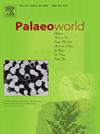Can the occurrence of the ammonite genus Hildoglochiceras Spath serve as an early Tithonian marker event?
IF 1.7
3区 地球科学
Q2 PALEONTOLOGY
引用次数: 0
Abstract
The 20–40° southern latitude-delimited Hildoglochiceras fauna enables correlation of South Tethyan early Tithonian rocks along the northwestern peri-Gondwana margin stretching from Madagascar to Nepal. Herein, a new assemblage of the ammonite genus Hildoglochiceras Spath is recorded from the Rupsi Shale Member of the Baisakhi Formation in the Jaisalmer Basin, western India, and consists of H. cf. latistrigatum (Uhlig), H. cf. kobelliforme (Bonarelli), H. cf. nodosum Prasad, and Hildoglochiceras sp. A. On its base, it is delimited by the occurrence of the early Tithonian Aulacosphinctoides cf. mayeri (Uhlig), A. perrinsmithi Uhlig, A. cf. tardissimus Enay, A. infundibulum (Uhlig) and A. cf. infundibulum (Uhlig) and, on its top, by the late Tithonian index Himalayites aff. seideli (Oppel). Based on the present and previous records from western India (i.e., from Kachchh and Jaisalmer basins), the occurrence of Hildoglochiceras Spath is correlated with the Standard Tethyan Darwini Zone of early Tithonian. It is plausible, and with more precise sampling from other western Gondwana margin localities, that the occurrence of Hildoglochiceras Spath may suggest an early Tithonian (Darwini to Semiforme zones) event, facilitating improved large-scale biostratigraphic correlations.
菊石属Hildoglochiceras Spath的出现是否可以作为早梯东世的标志事件?
以南纬20-40°为界的Hildoglochiceras动物群可以对从马达加斯加到尼泊尔的西北冈瓦纳边缘的南特提斯早梯东世岩石进行对比。本文记录了印度西部Jaisalmer盆地Baisakhi组Rupsi页岩段菊石属Hildoglochiceras Spath的新组合,由H. cflatistrigatum (uhlight)、H. cfkobelliforme (Bonarelli)、H. cfnodosum Prasad和Hildoglochiceras sp. a .组成。在其基础上,以早铁统aulacosphininctoides cfmayeri (uhlight)、a . perrinsmithi uhlight、a . cftardissimus Enay的出现为界。A. infundbulum (uhlight)和A. cf.infundbulum (uhlight),在其顶部,由喜马拉雅山脉的晚梯世指数aff.seideli (Oppel)组成。根据印度西部(即Kachchh和Jaisalmer盆地)的现有记录和前人记录,Hildoglochiceras Spath的出现与早梯东世标准特提斯达尔文带相对应。从其他冈瓦纳西部边缘地区更精确的采样来看,Hildoglochiceras Spath的出现可能暗示了早梯梯世(达尔文至半形成带)事件,促进了大规模生物地层对比的改善。
本文章由计算机程序翻译,如有差异,请以英文原文为准。
求助全文
约1分钟内获得全文
求助全文
来源期刊

Palaeoworld
PALEONTOLOGY-
CiteScore
4.00
自引率
5.90%
发文量
95
期刊介绍:
Palaeoworld is a peer-reviewed quarterly journal dedicated to the study of past life and its environment. We encourage submission of original manuscripts on all aspects of palaeontology and stratigraphy, comparisons of regional and global data in time and space, and results generated by interdisciplinary investigations in related fields. Some issues will be devoted entirely to a special theme whereas others will be composed of contributed articles. Palaeoworld is dedicated to serving a broad spectrum of geoscientists and palaeobiologists as well as serving as a resource for students in fields as diverse as palaeobiology, evolutionary biology, taxonomy and phylogeny, geobiology, historical geology, and palaeoenvironment.
Palaeoworld publishes original articles in the following areas:
•Phylogeny and taxonomic studies of all fossil groups
•Biostratigraphy, chemostratigraphy, chronostratigraphy
•Palaeoecology, palaeoenvironment and global changes throughout Earth history
•Tempo and mode of biological evolution
•Biological events in Earth history (e.g., extinctions, radiations)
•Ecosystem evolution
•Geobiology and molecular palaeobiology
•Palaeontological and stratigraphic methods
•Interdisciplinary studies focusing on fossils and strata
 求助内容:
求助内容: 应助结果提醒方式:
应助结果提醒方式:


